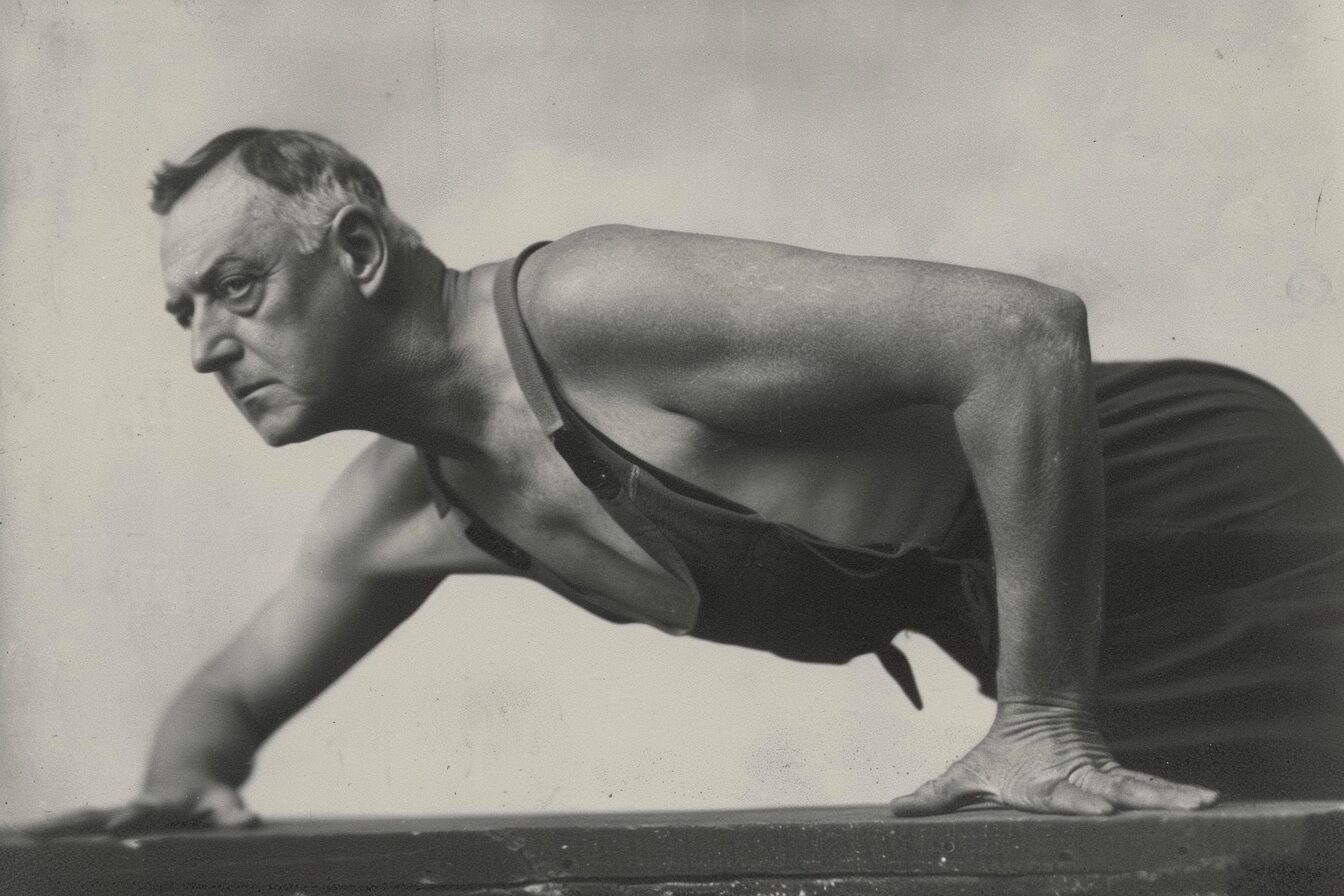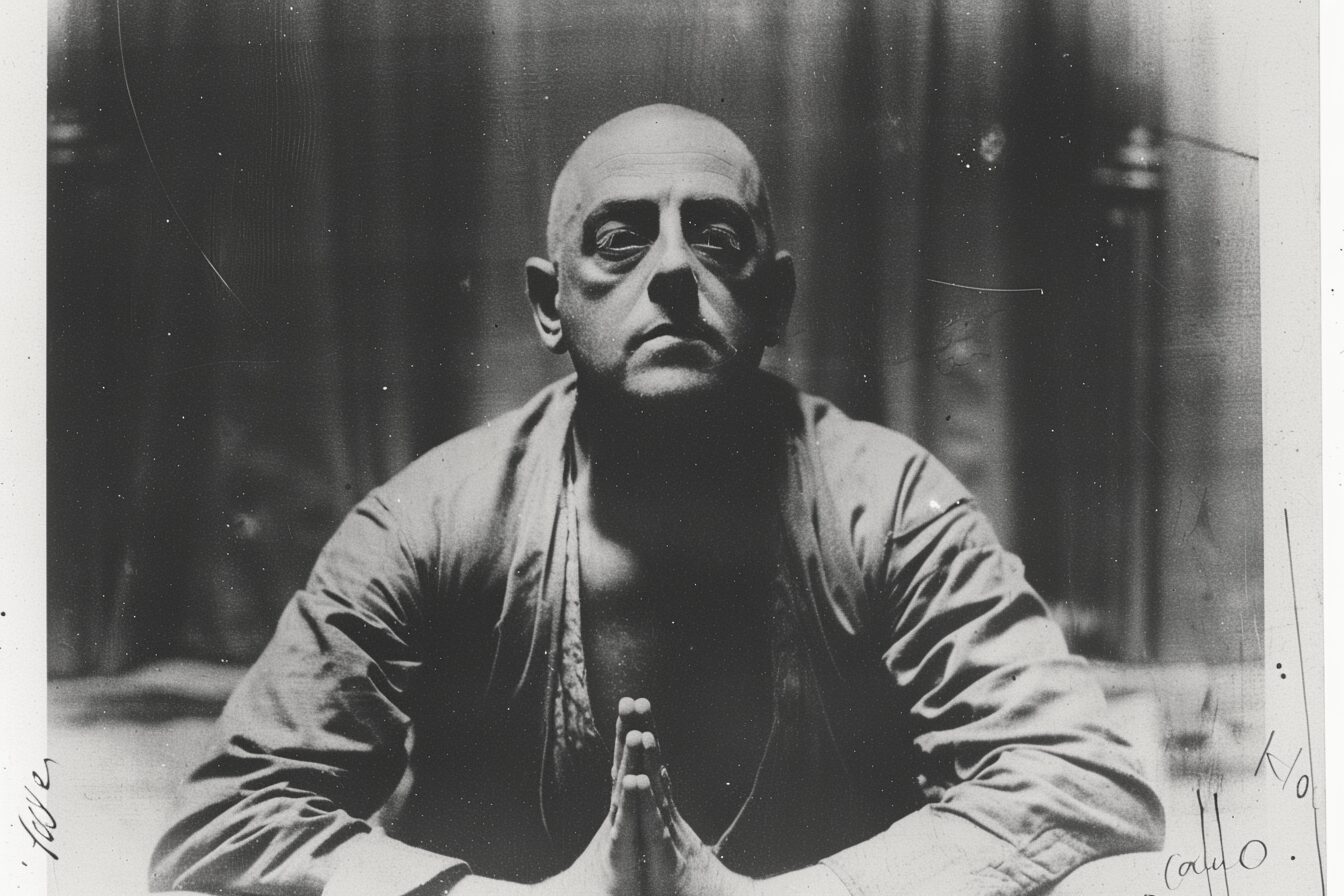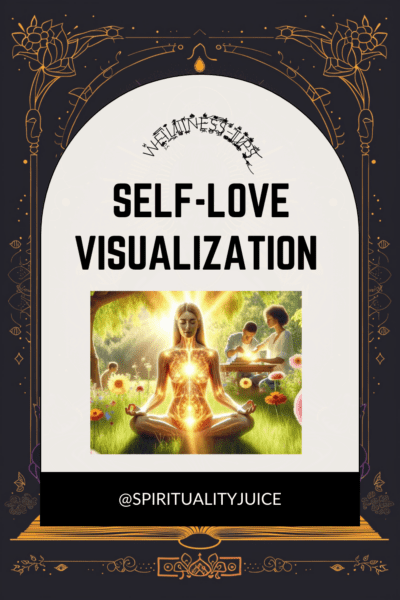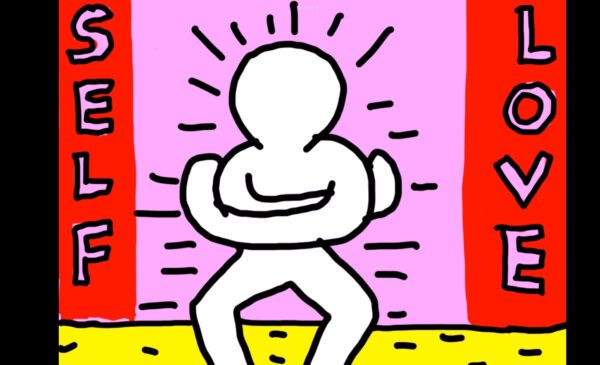Aleister Crowley gave eight yoga lectures, all shepherded by Mahatma Guru Sri Paramahansa Shivaji (pseudonymous Crowley). Crowley conveys the simplicity and universality of the Yoga style completely demystified.
Within this series of lectures, he emphasizes that Yoga incorporates the process of bringing together what is observed and the act of observation; it reveals the fact that the process between the things and that which makes things observable are the same.
Crowley does not stop at physical features of yoga but goes into spiritual and advises us to incorporate the idea of uniting with the divine while being careful enough to mention even things such as sadness and lust in the context of yoga. Being the guide which will lead Yoga lovers to develop a clear and definite perception of what Yoga means, without the mysticism or misleading Orientalist interpretations.

Here Crowley employs his state of the art, spirituality humor. Yoga for Yahoos.
Reframe that. Think of “Yoga for Yahoos” as”Yoga for the Unenlightened” or aka “Yoga for the West.”
Its a long lecture so let me break it up into main points.
Yoga for Yahoos !
Creating a Yoga Tradition for the West
In “Aleister Crowley Eight Lectures on Yoga,” Crowley is doing the seemingly impossible(for the time). He takes a stab at distilling yoga down to its essence, tossing it like a lifebuoy to our Western minds adrift in a sea of pragmatism.
It is my will to explain the subject of Yoga in clear language, without resort to jargon or the enunciation of fantastic hypotheses, in order that this great science may be thoroughly understood as of universal importance.
Why the Western Mind finds Yoga impalatable?
Crowley suggests that the Western mind is incapable of fully grasping Yoga due to its reliance on reason and intellect. But there are also other reasons why its so difficult.
For one relying on religious or mystical figures for ones instruction
Also the very essence of Yoga, a voyage into the caverns of the inner self, strikes a discordant note in the symphony of the materialism that overrides our western minds.
The very core of Yoga is that it is a self-discovery journey. That is, all the material world’s harmony becomes out of tune in its presence.

The Western mind is almost allergic to the mystical fragrance and devout dances of the East. Even spirituality has become a sort of commodity.
Crowley offers a glimpse at Truth, but only for those who see past the glamour of the spiritual ego and
What is Crowleys Solution? KISS Keep It Simple Stupid
There is more nonsense talked and written about Yoga than about anything else in the world.
What is Yoga? According to Aleister Crowley
He thought that Yoga is a school of practices and exercises that are meant to help people achieve the union with the divine or the higher self. According to this point of view, yoga can be conceived as a spiritual path which capitalizes upon physical postures, breath control, meditation and ethical principles to bring about spiritual development and enlightenment.
How does Crowley Definition of Yoga differ from “Traditional” definitions?
The approach to Yoga by Aleister Crowley stands out from the widely accepted conceptions or forms in several vital aspects.
Yoga and Magick
Firstly, he argues that Yoga is a combination of philosophy and science and thus both can be seen as a way of attaining states that go beyond the mind. Additionally, he describes how the Magick he has practiced serves as a foundation for his Yoga practice, implying a close correlation between the two arts.
Crowley also castigates the strinctly Hindu traditions connected with Yoga. Torturous and endless bodily positions and mystic theories, he says, are ineffective for the intended purposes. That is to raise ones consciousness. The wording Crowley uses is “to cross the abyss”.
He explains that by leaving behind the ordinary mind (Ruach) and reaching for a higher state of consciousness (Neschamah), one can transcend analytical thinking and achieve self-evident assurance
To Crowley Yoga is not about Poses, this is the true state of “Yoga”.
We may then ask ourselves whether it is not possible to obtain experience of a higher order, to discover and develop the faculty of mind which can transcend analysis, stable against all thought by virtue of its own self-evident assurance.
New Age Woo Woo
Second, Crowley points to the fact that Yoga is a simple and universal philosophy in spite of the widespread mainstream ideas that it is full of mysteries and it that it is only an Eastern Mystery School. He underlines that Yoga is based on the union of the subject and object of consciousness, thus, demonstrating the link between the knowing agent and the known.
The concept of union between the subject and object of consciousness in the context of Yoga
Aleister Crowley goes on to say that by dealing with the cardinal principle of union between the subject and object marks the ultimate point of self-realization and spiritual awakening.
This ultimately leads to a superposition, the Hindi term for which is samadhi or satori, which signifies the state of mind attained by the fusion of observer (subject) and the observed (object).
Minds melded like Gohan and Trunks.
Interbeing
Interweaving Essence: This term burgeoned in recognition and profundity through the sage efforts of the Vietnamese Buddhist monk, Thich Nhat Hanh. In his venerable script and discourse, he profoundly expanded and heralded this concept.
The underlying ideas of interbeing resonate with core Buddhist principles like dependent origination (pratītyasamutpāda), which emphasizes the interconnectedness of all phenomena.

Embodied within Yoga philosophy is the pursuit of such union leading to a higher state of awareness and mind wherein the distinctions between the self and the external stimuli start to fade away.
This elevated state supersedes ordinary thoughts and consciousness, opening the door to understanding reality which is not merely a product of the mind.
“We are to unite the subject and object of consciousness in the ecstasy which soon turns, as we shall find later on, into the more sublime state of indifference”
Yoga points to the fact that everything which is perceived is created in the realm of one’s mind, which makes the mind the only center of exploration. Through cognizing the essence of consciousness, the interaction between the individual awareness and the external universe is, thus, the aim for the Yoga practitioners, who seek to unify their individual consciousness with the universal consciousness.
Emphasizing the connection between the seer and the seen
The thing that is most important in Yoga is the unity of the seer and the seen. More generally yoga is a religious training system dedicated to the liberation of the individual and the transcendence of the line that separates subjective and objective perception. Crowley suggests that each one of the thoughts and ideas is logically tied with each of the others, however, that there symbolizes this ties as the connection between a star and rays of light. This interdependence highlights the interrelationships of all elements, as well as the relationship between the ‘seen’ and the ‘seer’.
The practice of Yoga unfolds through various stages:
- Pratyahara (introspection): in the context of Yoga, marks a significant stage in the practitioner’s spiritual journey.
- Dharana (concentration on a single object): In this stage, practitioners focus their attention on a chosen object or point of focus, such as a mantra, a visual symbol (like a candle flame), or the breath.
On the deeper level, uniting the I and the It of spiritual consciousness within Yoga implies the perfect harmony of the individual self with the whole universe, expressing itself in the unparalleled spiritual experience and a more profound understanding of the fabric of the world.
Eight Limbs of Yoga
Within the eight limbs of Yoga, there are some very significant aspects and levels of practice. These limbs are meant to help a practitioner towards spiritual realization and self-discovery. Like training wheels you put on a bike before riding. They are as follows:
- Ethical principles The first limb of yoga which is the Yama , the rules for the relationship with the outside world and the moral rules.
- personal observances and self-discipline The second limb Niyama regulates the personal observances and self-discipline that are required for spiritual growth and self-purification.
- Asana The third limb refers to the physical postures and movements that are made in order to prepare the body for mediation and other spiritual practices.
- Pranayama Comprises of the practices of controlling the breath, which are meant to balance the prana inside the body and achieve the mental peace.
- Pratyahara The fifth limb, Comprises of the practices of controlling the breath, which are meant to balance the prana inside the body and achieve the mental peace.
- Dharana The sixth limb, which is the act of focusing the mind on a singular location or object during meditation.
- Dhyana The seventh limb, dedicated to meditation and the cultivation of sustained, focused awareness on the chosen object of meditation.
- Samadhi The last limb, symbolizing the stage of unity and oneness with the divine or higher consciousness, when a person transcends the self to reach ultimate bliss and enlightenment.
How does the concept of the eight limbs of Yoga contribute to the spiritual growth and self-realization of the practitioner?
Consider, the eight limbs of Yoga are a holistic system for spiritual transformation and self-knowledge, which enables a practitioner to explore themselves, divine relationship and existence in a deeper level. Naturally, adhering to these principles with faithfulness leads to a state of divine unity and brings about a transformation of a great magnitude in our souls.
Making the Yogic process More Effective
In this portion of ‘Aleister Crowley Eight Lectures on Yoga,’ Crowley provides a comprehensive overview of Yogic principles. He explains the fundamental concept of achieving stillness through the cessation of thought and sensory stimuli. Crowley underscores the universality of Yogic philosophy and its applicability to all aspects of existence. With clarity and precision, he offers practical instructions for beginners, outlining the initial steps toward mastering the ancient art of Yoga.
‘We place no reliance
On Virgin or Pigeon;
Our method is science,
Our aim is religion.’
Turning your focus inside
In the exploration of our deepest self, the concept of Pratyahara stands as a beacon, guiding us towards an inward journey that transcends the mere physicality of our existence. This profound yogic practice, nestled within the ancient texts, beckons us to withdraw our senses from the external clamor, directing them instead towards the vastness that lies within. It is here, in the silence and solitude of our inner world, that we encounter the essence of our being.
Aleister Crowley, with his unparalleled insight into the mystical, observed the contradiction inherent in Pratyahara. It is a dance of duality, where the focus on self-needs and interests paradoxically opens the door to a deeper understanding of the universal interconnectedness of existence. This introspective practice, though seemingly centered around the individual, ultimately leads to a realization of the oneness that permeates all.
Moreover, Crowley’s teachings delve into the liberation that comes from relinquishing deeply held virtues and beliefs as one advances on the spiritual path. The evolution of one’s yoga practice brings about a pivotal moment where the virtues that once guided us no longer serve our journey towards discovering our true Will and the essence of our passion. It’s a radical shift, a letting go of preconceived notions and attachments, to embrace a higher truth.
Additionally, the journey through yoga, as Crowley indicates, is not without its challenges. The significance of establishing a strategic plan for one’s spiritual path cannot be overstated. Life, with its unforeseen trials and tribulations, demands a level of foresight and planning to navigate the complexities of the spiritual quest successfully. It’s a testament to the necessity of being prepared, of mapping out one’s spiritual journey with the wisdom and anticipation of a seasoned traveler.
In conclusion, the teachings of Aleister Crowley on Pratyahara, the act of giving up certain virtues, and the essential nature of strategic planning in yoga, offer a rich tapestry of wisdom for those embarking on the inner journey. It’s a path that demands courage, a willingness to confront the contradictions within, and the resolve to let go of what no longer serves us. In doing so, we find ourselves stepping into the light of our true essence, ready to embrace the unity of existence that Pratyahara ultimately reveals.
Tools
Aleister Crowley’s shortcut to Yogic practice relies on a practical, reasonable, and universal approach.He presents Yoga as a direct tool of religious preparation that anybody may practice.Crowley highlights the value of the Yama principle, which involves the controlled refusal of bad outside influences, by highlighting the necessity to arrange one’s life by avoiding distractions and disruptions.
He asserts that an approach grounded in experience and observation is essential, emphasizing the exclusion of mystical characters from our education. He advocates for self-reliance rather than dependency on such characters.
He bases all his claims on are scientific principles, showing that both consciousness and experiences are subject to scientific scrutiny.
Humor & the Spirit of Yoga
In Aleister Crowley’s lecture he gives practical advice in the form of humor. He seemingly weaves comedy into his teachings to provide a unique and engaging perspective. He emphasizes the importance of daily practice and careful planning in one’s spiritual journey, acknowledging the challenges and unexpected problems that may arise during the training. He encourages the use of personal experience and observation, rather than relying on traditional authorities, to navigate the complexities of spiritual growth.
Liber III. vel Jugorum
One practical exercise recommended by Crowley is the performance of Liber III. vel Jugorum, which involves the discipline of repeatedly cutting oneself when using a familiar thought, word, or gesture as a way to enhance concentration.
It really isnt that much differnt form snapping a rubber band around your wrist everytime you have a negative thought.
The Mathematical and Magical Standpoint of Yoga
Imagine a word so powerful that saying it just right could unravel the fabric of the universe. That’s the mystique Aleister Crowley introduces us to with the Tetragrammaton formula. That is the ineffible name.
In Aleister Crowley’s Yoga lectures he concentrates his attention on both “The Mathematical and Magical Standpoint of Yoga,” and the respective Tetragrammaton formula.

The Interconnection of Magick and Yoga
Crowley believes this formulation provides such an exclusive insight into the mysteries of magical processes that it is linked with the name (the ineffible name) which is not pronounced, cannot be pronounced. It is such an exceedingly strong formula, supposedly able to alter the celestial spheres.
The Tetragrammaton is a Greek word and means “the four-letter name.” It represents the four-letter name of God; the four Hebrew letters Yod, Heh, Vav, Heh, transliterated into YHVH.
According to him this sign being instructive of merging of ones consciousness with the universe this expression comes very close to the Yoga’s very essence.
Moreover, Crowley adds his two cents about yoga and magick, in such sense that the influence of one on mastering the other is inevitable.
Yoga has been elevated to a present element of his life, which Crowley credits being the cause of that which had bred in him spiritual heights. Crowley treats Yoga as a path to wholistic harmony via prioritizing silence over dialogue to gain access of silence of the universes. He also disapproves some irrational and elaborate beliefs over Yoga, the practical and scientific study of which is possible. Finally, Crowley states that yoga, is, in essence, the awareness of being the observer and the observed, a spiritual journey of inwardness that aims at the perception of reality’s absolute.
Science
Crowley didn’t stop at mere theoretical musings; he was a proponent of empirical experimentation in the spiritual domain. He believed in the power of observed facts, suggesting that through meticulous observation and experimentation, we could work our way back to a coherent metaphysic. This approach places Crowley at the intersection of science and spirituality, where observed evidence becomes the cornerstone of metaphysical understanding.
Furthermore, Crowley introduces us to the concept of initiation in Magick, which he describes as a spontaneous and automatic process that leads to interactions with higher entities and the acquisition of new powers. This notion parallels the scientific principle of growth and progression, presenting initiation as a natural evolution in the journey of spiritual discovery.
Inhibiting bodily and mental stimul
Conclusion
This final point focuses on the integration of Magick and Yoga so that individuals can utilize both to complement and strengthen their practices. He addresses the challenges that come during Yoga practice and urges individuals to confront their limits, whether in the mind or in everyday life, in order to achieve total spiritual serenity.
Overall, Aleister Crowley’s approach to Yoga reduces the difficulty of the practice by emphasizing the down to earth methods, scientific principles, and individual experiences, which in turn make it more understandable and available to a larger sector of people.
Ultimately Aleister Crowley Eight Lectures on Yoga invites us to ponder the incomprehensible vastness of the universe within the realm of Yoga, suggesting that reality unfolds far beyond the limitations of our minds. Through Yoga, we come to realize that the universe whispers its secrets to those who listen with open hearts. Embracing the mystery, we unlock the doors to profound interconnectedness and transcendence, uniting with the divine essence that permeates all creation.
Aleister Crowley explores the idea of the incomprehensibility of the world in terms of Yoga, pointing out that the nature of reality is beyond the scope of human intellect and reason. He notes that in the process of Yoga, one can come to understand that the universe is beyond the reach of our ordinary ways of perception. Acknowledging that there are inexplicable and mysterious aspects of existence is an important part of Yoga practice, as it requires a change in consciousness towards the deeper realization of the interdependence of all things.
Crowley points out that even if you understand concepts intellectually, it still does not mean that you have grasped the essence of reality, as it is beyond the boundaries of rational thinking. By the performing of Yoga, people try transcending the bounds of normal mind, so that they might have deep insights into the transcendental truths of life.
In the Yoga context, the incoherence of the universe becomes a trigger for spiritual development and self-realization. Acknowledging the inherent restrictions of the human mind in understanding the complexity and immensity of the universe makes one develop a sense of humility and readiness to the unknown. This recognition of the unfathomable character of the world leads to a closer relationship with the divine and a greater feeling of harmony with all that exists.
Finally, Crowley’s teachings regarding Yoga highlight the necessity of accepting the mystery and illogicality of the universe as an essential part of the spiritual path. Yoga enables people to move beyond the limits of ordinary understanding and access a higher level of awareness that discloses the unity of all things and results in a deep sense of union with the divine.



